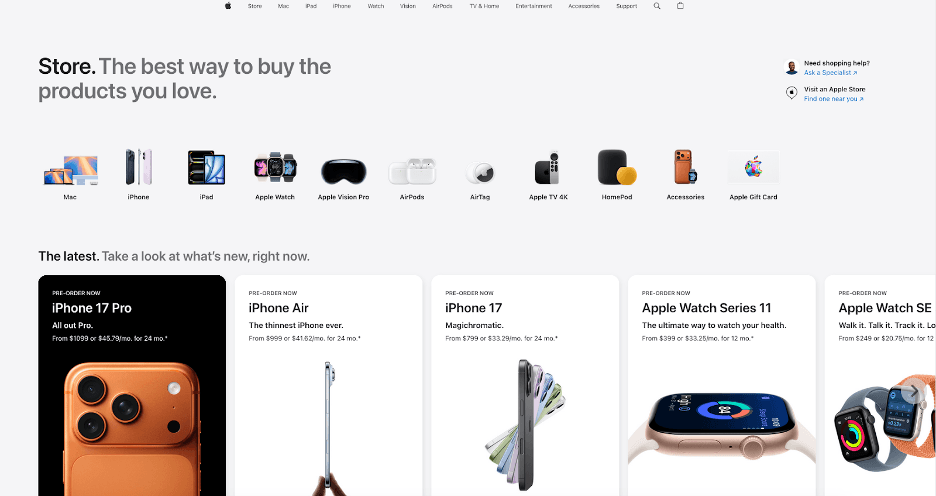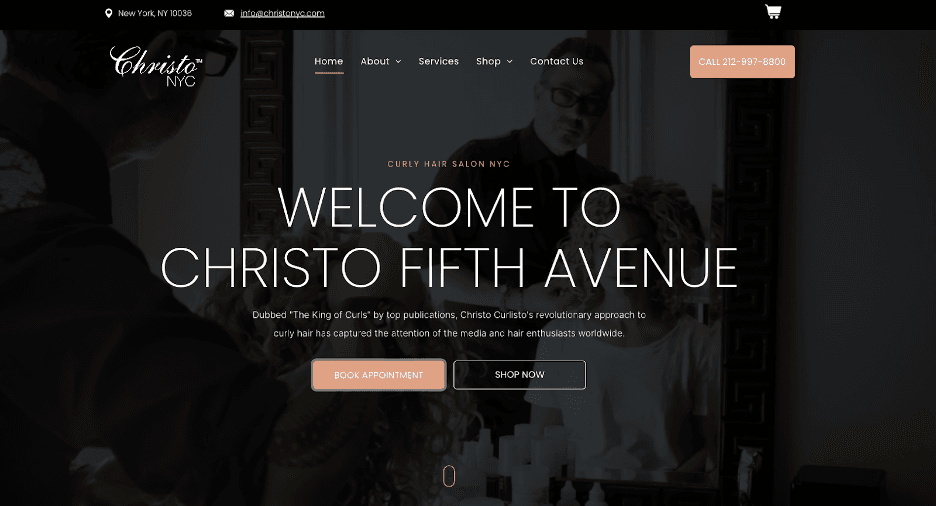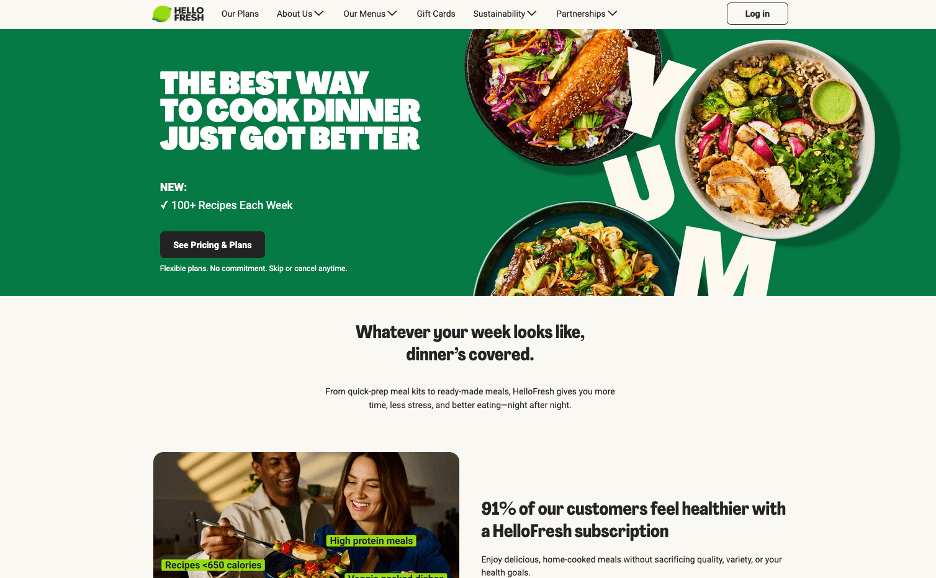Business.com aims to help business owners make informed decisions to support and grow their companies. We research and recommend products and services suitable for various business types, investing thousands of hours each year in this process.
As a business, we need to generate revenue to sustain our content. We have financial relationships with some companies we cover, earning commissions when readers purchase from our partners or share information about their needs. These relationships do not dictate our advice and recommendations. Our editorial team independently evaluates and recommends products and services based on their research and expertise. Learn more about our process and partners here.
Website Design Tips for Small Businesses
A website may be your business's only chance to make a positive first impression. Here's how to make it count.

Table of Contents
Your website’s design is crucial to your online presence and digital marketing strategy. A well-designed website conveys professionalism. By presenting clear, consistent and easy-to-find information, your website can help you earn repeat business and foster customer loyalty.
We’ll explore best practices and tools for optimizing your website design process, along with examples from standout business websites.
Website design best practices
Whether you’re building a new website or improving an existing one, these 11 tips will help you create an appealing, functional site that keeps customers and prospects engaged.
1. Create a detailed plan first.
When creating or redesigning a website, your first step should be to develop a detailed plan of what you want to do, how to do it and how each website element will help serve your customers.
To get started, you’ll need to pinpoint your target audience and create a customer journey map from start to finish. Customer data informs each design step and determines what your website should offer. For this step, you should gather solid data on the following:
- Who your customers are
- What they want to accomplish on your website
- How they typically navigate websites
- What devices they use most often
2. Keep your design simple and clean.
Modern website design is clear, crisp and efficient, so get rid of anything clunky and unnecessary. Consider removing the following features:
- Flash animations
- Auto-playing music or videos
- Too many pop-ups
- Excessive graphics that don’t serve a purpose
Today’s busy customers have short attention spans and don’t want to wade through pages of fluff content to find what they need. Meet customer needs with a straightforward website design that helps them quickly solve their problems.
3. Integrate social media.
Your online presence should be a cohesive unit, with your website as the hub. Consider incorporating buttons on your website that link to your social platforms, including Facebook, X, LinkedIn and Instagram. Ideally, place them in a footer that travels with the customer as they click from page to page.
4. Create a scrollable homepage.
With more people than ever visiting websites via tablets and mobile devices, a scrollable homepage ensures your website is accessible to a wider audience.
Additionally, a scrollable homepage is modern and engaging because you can animate website elements to pop up or move as the user scrolls to them. This design adds an element of interest without being overpowering or distracting.
Organize your scrollable homepage into sections to make it easy to navigate. It should include the following:
- Hero section with a clear value proposition
- About page explaining your business
- Services or products overview
- Customer testimonials or social proof
- Contact information and calls to action (CTAs)
5. Use white space effectively.
White space is no longer something to avoid. Use white space to help break up pages and make your content easier to read by prioritizing essential text. White space can also help you determine where to place other page elements.
6. Make your site mobile-responsive.
According to Statista, more than 62 percent of global web traffic comes from mobile devices. Additionally, Google found that 86 percent of users prefer mobile-friendly sites, and 75 percent will return to a website that performs well on a mobile device. Notably, 65 percent say they’re more likely to buy a product or use a service if the site is mobile-friendly.
It’s clear that businesses must make their websites mobile-friendly. Ensure your website is mobile-responsive and looks just as good on smaller screens as it does on desktops. Tailor your mobile site to respond directly to visitors’ needs. Consider why they’re accessing your mobile site and what they’re looking for, and make it easy for them to get that information.
7. Optimize for search engines.
Search engine optimization (SEO) is vital for any business’s online presence and should be considered at every step of creating or redesigning your website. Consider what content is relevant and interesting to your customers, and build your SEO strategy to cater to that content.
8. Implement strong website security.
Customers are highly concerned about and protective of their personal information. Do everything you can to give them the peace of mind of knowing their data is safe on your site.
Website security measures include having a current SSL certificate. This small data file binds a cryptographic key to your business and secures credit card transactions, data transfers, logins and browsing. A current SSL certificate is essential because it creates the HTTPS application protocol and the padlock symbol in a user’s search bar. If your website doesn’t have an HTTPS application protocol, Google may flag it as not secure and warn visitors.
9. Use AI website builders for efficiency.
Building a website used to be difficult and time-consuming, but that’s no longer the case thanks to AI website builders. These tools streamline the entire process, from designing the site to helping you create content.
Most of these tools are easy to use and offer a variety of premade templates to choose from. Look for software like Wix, which allows you to start the process using AI and tweak the design and content once it’s finished.
10. Choose typography wisely.
Selecting the right fonts is one of the most underrated aspects of website design. The correct font reinforces your brand’s message and helps users easily navigate your website. The fonts you choose should complement the overall design and match your brand’s personality. Avoid anything that’s hard to read, such as cursive or script fonts.
11. Select an appropriate color scheme.
Less is often more when it comes to choosing colors for your website. Color plays a big role in determining how consumers feel about your brand, and there’s a lot of strategy that goes into choosing the right color scheme.
You want to choose colors that are either monochromatic, complementary or analogous.
- Monochromatic: Monochromatic colors use one main color for the design, which works well for an understated look, but make sure you include a little contrast to keep things interesting.
- Complementary: Complementary colors create a striking appearance that catches the user’s attention. Ensure the colors you choose work well together and aren’t distracting.
- Analogous: Analogous colors sit next to each other on the color wheel and tend to be visually appealing. But like monochromatic design, you want to make sure you include adequate contrast.
Essential website elements
A strong business website combines design, content and performance so visitors have a smooth, professional experience. Here are the elements every site should include:
- Clear navigation: Visitors come to your site with a goal, such as checking prices, finding support or learning about your services. Make it easy for them to get where they’re going. Use clear labels, group related topics under broad headings and keep menus simple. For larger sites, add breadcrumb navigation so users can easily backtrack.
- Responsive design: With so many people browsing on phones and tablets, your site should look good and work well on any screen. Responsive design automatically adjusts layouts, images and menus for different devices, which improves the user experience and helps your search rankings.
- Consistent branding: Your website should reflect your brand image at every click. Stick to the same colors, fonts and layouts across pages so everything feels cohesive. A simple style guide makes it easy to keep your look consistent as you add new pages or features.
- Smart use of images and video: Photos and videos bring your site to life, but too many can overwhelm users. For video content marketing and images, consider explainer videos or product photos, and place them strategically after text blocks.
- Quality copy: Your words matter just as much as your design. Website copy should be clear, error-free and easy to understand. Use an authentic and consistent brand voice to help customers instantly recognize your business across every channel.
- Strong CTAs: CTAs guide visitors to take the next step, whether that’s signing up for an email newsletter, booking a demo or making a purchase. Make buttons bold and eye-catching, and place them throughout your site to encourage action at key moments and generate more leads and sales.
- Fast load speeds: If your site takes too long to load, visitors won’t wait around. Aim for pages that load in under three seconds. Tools like Google PageSpeed Insights can help you spot slowdowns and suggest fixes.
Common web design pitfalls and solutions
Even the best sites can run into website design mistakes that frustrate visitors and hurt your business goals. The good news? Most issues have simple fixes. Here are some common pitfalls and how to avoid them:
Design and layout issues
- Cluttered layouts: Too many elements on a page can overwhelm visitors. The fix: add white space, highlight your most important content, and stick to a limited set of fonts and colors.
- Poor navigation: Confusing menus or unclear calls to action leave users stuck. The fix: use clear, intuitive labels, keep your main navigation simple and add breadcrumbs for larger sites.
- Non-responsive design: If your site isn’t optimized for mobile, you risk losing the majority of your audience. The fix: build with responsive web design from the start using flexible grids and media queries.
Technical and performance problems
- Slow load times: Large images and heavy code drag down performance. The fix: compress photos and images, use lazy loading, streamline your code and take advantage of browser caching.
- Weak security: Outdated website security leaves visitors wary. The fix: keep SSL certificates current, update your software regularly and follow secure coding practices.
Content and accessibility issues
- Poor readability: Tiny fonts and low contrast make content hard to read. The fix: choose legible fonts, use strong contrast and organize content with headers and bullet points.
- Ignoring accessibility: Overlooking users with disabilities cuts off a large audience and could create compliance issues. The fix: follow WCAG 2.1 guidelines, add alt text to images, and ensure your site is accessible with keyboard navigation. (More on accessibility issues below.)
DIY vs. professional design: Making the right choice
When it comes to building a website, you’ll need to decide whether to use a DIY website builder or bring in a professional designer. The best choice depends on your budget, goals and how hands-on you want to be.
Consider DIY if …
- You’re working with a tight budget and need a cost-effective solution.
- Your site only needs basic pages without complex features or integrations.
- You need to get online quickly, such as for a product launch or a temporary site.
- You want direct control and don’t mind learning how to manage the site yourself.
Hire a professional if …
- You need custom features, advanced functionality or unique branding.
- You want your website to stand out instead of looking like a template.
- Search engine visibility and site performance are top priorities.
- Your business is growing and you’ll need a site that can scale with it.
- You want peace of mind with ongoing support, security and maintenance.
You can also mix the two approaches. Some businesses start with a DIY platform and then bring in a designer later, while others use a hybrid approach — consulting with a pro for the initial design and strategy, but handling updates in-house.
Advanced website design considerations
Once you’ve mastered the basics of web design, more advanced strategies can help take your site to the next level. Consider the following:
Accessibility standards
Providing accessible design isn’t just about compliance — it’s a form of business accommodation that shows customers you value their needs. The Web Content Accessibility Guidelines (WCAG) are the global standard for accessible design. They’re built around four core principles, often called POUR:
- Perceivable: A website should present information in ways all users can sense. For example, add text alternatives for images and ensure strong color contrast.
- Operable: It’s important to ensure visitors can navigate using various methods, including a keyboard.
- Understandable: It’s crucial to keep content and navigation clear and intuitive.
- Robust: Focus on designing content that works with assistive technologies and remains functional as new technologies emerge.
The latest WCAG 2.2 guidelines add new requirements that improve accessibility for people with cognitive and motor disabilities as well as mobile users. Meeting WCAG 2.1 Level AA is the target most organizations aim for, since it’s often required by law or contracts. In fact, the U.S. Department of Justice issued new rules in March 2024 requiring certain organizations to comply.
Conversion optimization
A well-designed website doesn’t just look good; it guides visitors toward taking action. Here are a few tips to help boost successful conversions:
- Highlight calls to action: Use contrasting colors and strong placement so buttons stand out.
- Build trust: Show testimonials, reviews, security badges and social proof. Even small design changes, like making review stars more visible, can improve performance.
- Create urgency: Limited-time offers, countdowns and scarcity messaging can encourage faster decisions.
- Simplify forms: Ask only for what you need, enable auto-fill and break up longer forms into smaller steps.
User experience (UX) design
Good UX design means creating a website that feels easy, natural and helpful for your visitors. To get there, you need to understand how people actually use your site and what gets in their way.
Businesses usually look at three kinds of market research to better understand their users and what they want:
- Descriptive research: Observing how users interact with your site to spot common behaviors and pain points.
- Evaluative research: Testing new layouts, designs or features to see if they work well for real users.
- Causal research: Exploring the reasons behind user behavior, for example, why users abandon shopping carts.
Two practical frameworks can guide your design work:
- Design thinking: This is a five-step process (empathize, define, ideate, prototype, test) that keeps the user’s needs at the center of every decision.
- Jakob Nielsen’s usability heuristics: This framework boils down to basics like giving clear feedback (so users always know what’s happening), using familiar language, keeping design consistent and letting users easily undo mistakes.
Website performance metrics and benchmarks
How fast and smoothly your site runs makes a big difference in both search rankings and user satisfaction. Google and other search engines pay close attention to performance, and so do your visitors. Here are some of the most important benchmarks to keep in mind:
- Core Web Vitals: Google uses these as key ranking factors:
- Largest Contentful Paint (LCP): The main content on a page should load within 2.5 seconds.
- Interaction to Next Paint (INP): Google’s new responsiveness metric should be under 200 milliseconds. (This metric replaced First Input Delay in March 2024.)
- Cumulative Layout Shift (CLS): Pages shouldn’t jump around as they load. Aim for less than 0.1.
- Page load speed: Your page load speed should be under three seconds. Any longer, and users may click away.
- Time to first byte (TTFB): This measures how quickly the server responds. Under 200 milliseconds is ideal.
- Mobile performance: As more people worldwide access the internet through mobile devices, it’s crucial to optimize your site for mobile browsing.
- Conversion benchmarks: Conversion rates vary greatly by industry, but some averages can help you set realistic goals. According to 2025 Google Ads benchmarks, campaigns average 6.6 percent overall, with the arts and entertainment industry at 13.10 percent and physicians at 6.73 percent.
Emerging trends and future considerations
Web design keeps evolving, and staying on top of new trends can give your business a competitive edge. Here are a few changes shaping the future of websites:
- AI integration: AI is making websites smarter and more personalized. From AI chatbots that answer questions instantly to tools that recommend products based on browsing history, AI helps businesses deliver experiences tailored to each visitor.
- Voice interfaces: As more people use Siri, Alexa and Google Assistant, voice search is becoming a bigger part of how customers find businesses. Optimizing your site for voice involves using clear language, adding schema markup and ensuring your site functions well for individuals who prefer speaking over typing.
- Interactive experiences: Modern websites are moving beyond static text and images. Subtle motion effects, interactive storytelling and immersive visuals can make your site more memorable (as long as they don’t slow down performance). Think product demos, explainer videos or even light gamification to keep visitors engaged.
Why website design matters
Your website is often the first place people interact with your business, and first impressions count. A polished design doesn’t just look nice; it builds trust, guides visitors and helps turn traffic into sales.
“A website works best when it serves both the business and the visitor,” explained Adriane Galea, founder of Visionaries. “For the business, it should have clear calls to action and help convert traffic into customers, leads, clients and so on. For the visitor, it should provide an easy solution to their problem or query.”
Here are six big reasons design matters:
- First impressions: Your website is often the first interaction potential customers have with your brand.
- Credibility: A professional look builds trust and positions you as an authority in your field.
- User experience: Clear layouts and intuitive navigation make it easy for visitors to find what they need.
- SEO benefits: Search engines reward sites that are well-designed, fast and mobile-friendly.
- Conversions: Smart design elements — like calls to action — encourage visitors to take the next step.
Website design examples
We consulted with experts to pinpoint business websites with excellent designs. Check out these business website designs to help inspire your strategy:
Apple
Apple has mastered clean, clear minimalist design, and the company’s products and website embody that aesthetic.
“I love Apple’s web design and how they get right to the point with a seamless experience for the end user,” said Teo Vanyo, CEO of StealthAgents. The website is visually engaging and easy to navigate, and it carries a cohesive style throughout every page.

Christo NYC
Christo NYC is a New York City-based hair salon with a modern, sleek website that showcases the business and makes it easy to book appointments and learn about services. Christo NYC incorporates appealing images without overwhelming the page and has a clear brand style.
“I like Christo’s website because it immediately leads people to booking, has a good flow of information, establishes credibility with great website copy, and uses a simple and easy design,” Galea said.

HelloFresh
HelloFresh is a popular meal kit delivery business. The company’s website uses bright colors, punchy copy and a scrollable design. The homepage is engaging, with clear sections and multiple calls to action.
“If you visit their website, you will notice that everything is available from the homepage,” said Ryan Scribner, co-owner of personal finance blog Investing Simple. “You can learn about the product, sign up for a subscription plan and even read the FAQ right from the homepage. Most people who visit the site will have their questions answered right on the homepage, meaning they don’t have to go digging for information.”

Gotham Greens
Gotham Greens is a greens grower and distributor based in New York City. The company’s website uses a modern, minimalist aesthetic with a scrollable homepage. The website’s copy is minimal and direct, making it easy for customers to learn what the business does and find what they need.
“It’s simple but effective, utilizing a one-page design to present the most relevant information without the user having to do more than scroll,” said Jake Hill, CEO of DebtHammer.

Website design tools and resources
The best website builders and design services can help you create the perfect website. We’ll highlight a few that business owners and marketers recommend.
Wix
Wix offers free, customizable website templates for creating your website pages.
“There are many free resources out there that offer templates that are completely customizable, but one of my favorites is Wix,” said Kelly Andersen, senior marketing associate at K2 Advisors. “They have beautiful designs, and it is simple to create a completely customized website that is also optimized for mobile, and that will also be able to be found on Google and other search engines.”
Learn more about how Wix can solve your web design needs.
Figma and Sketch
Figma and Sketch are two web-based vector graphics editors and prototyping tools that allow users to design, prototype and collect customer feedback. They both offer collaboration features like real-time feedback and easy file sharing, allowing team members to work together seamlessly.
“We recommend Figma and Sketch,” said Paula Glynn, director of search marketing and digital strategy at Pixelstorm. “These tools integrate really well into the web development process, and using these [tools] results in pixel-perfect websites.”
Canva
Canva is a graphic design platform you can use to create multiple types of visual content, including website graphics. Canva is free, but paid subscriptions offer increased functionality.
“Canva is, hands down, the best resource for easily creating professional-looking graphics, logos and more, and can also be a huge help in creating content for social media,” Galea said.
Elementor
Elementor is a software company that allows users of the WordPress website builder to create and edit their websites using a drag-and-drop builder tool. The software features a built-in responsive mode and can help you speed up your website, drive traffic and create professional-looking web pages.
“I love Elementor. It’s a drag-and-drop website design tool, and you don’t need to have any website design experience to use it,” said Julian Goldie, who runs an SEO link-building business. “What would normally take you hours to code (or a lot of money in website design staff) can easily be achieved in minutes with Elementor.”
Hotjar
Hotjar is a behavior analytics tool that analyzes website use and provides feedback in the form of heat maps, session recordings and surveys to help you determine which parts of your website are performing well and which require attention.
“A heat map [allows] a webmaster to install a snippet of code on their site,” explained Ben McLaughlan, founder and owner of Easy Mode Media. “The app then records valuable information about audience interaction with the website. If there is a section of the page that people click away from or a button that never gets clicked, this is important information when optimizing a website and landing page for conversions.”
Jamie Johnson and Kiely Kuligowski contributed to this article. Some source interviews were conducted for a previous version of this article.












